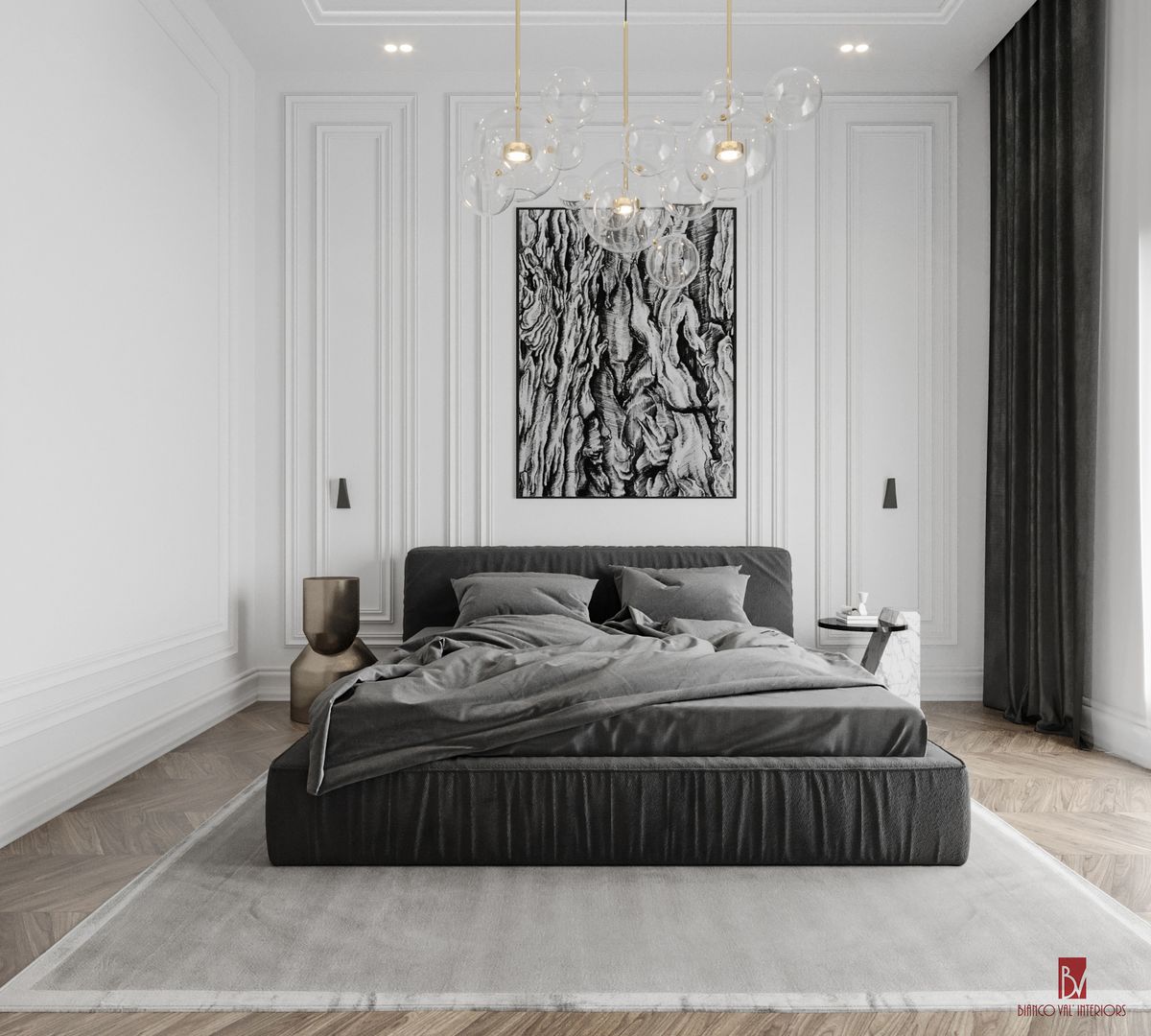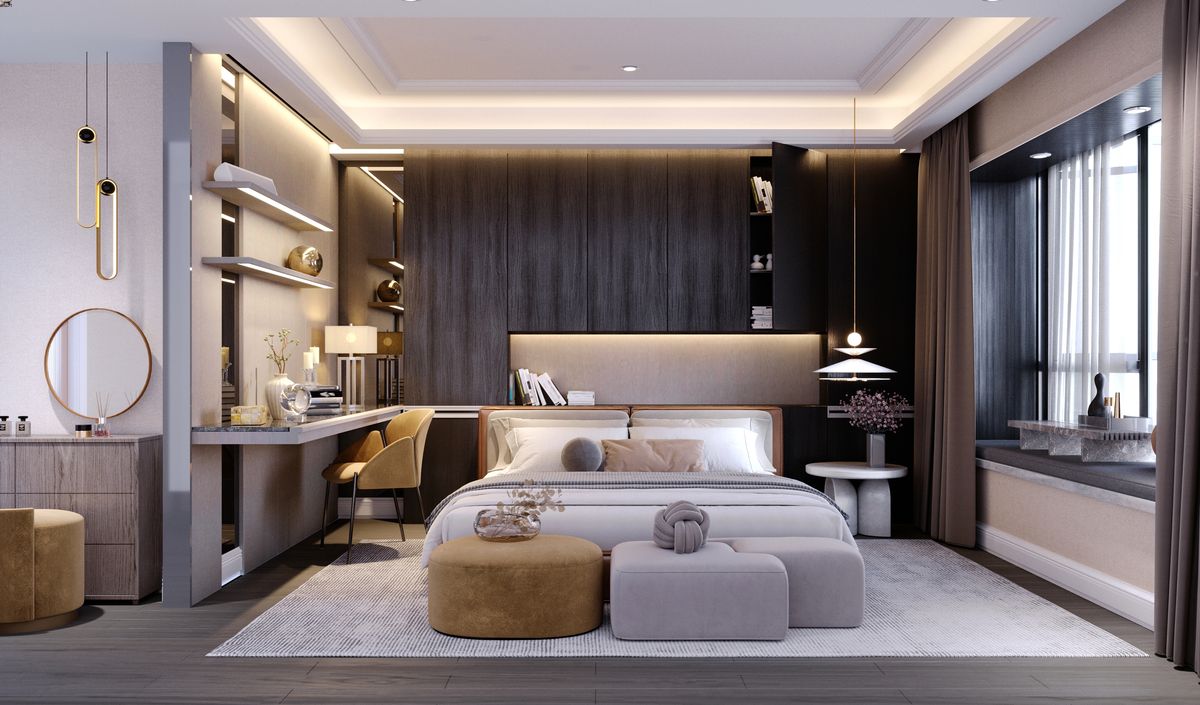Creating the perfect interior design for your bedroom requires careful planning and consideration. It’s all about creating a space that not only functions well but also reflects your unique style.
Choosing the right colour scheme and furniture arrangement is crucial for achieving a cohesive design. Colors have the incredible ability to influence emotions and set the overall mood of a bedroom.
So, it’s important to pick a palette that resonates with you. And don’t forget about arranging the furniture in a way that allows for easy movement and accessibility, making the space both practical and visually appealing.
In this article, we’ll explore the essential elements and techniques you can apply in designing a room that meets your needs and showcases your personal taste.

Things to Consider Before Starting a Bedroom Interior Design
1. Creating a Comfortable and Cohesive Space
Achieving a comfortable and cohesive space is essential in designing any bedroom. Bear in mind that your design is meant to create an environment that promotes relaxation and harmony, where every element blends seamlessly together.
- Thoughtful Furniture Placement: Utilize furniture arrangement to ensure ease of movement and optimize functionality within the space.
- Harmonious Color Palette: Select colors that complement each other and create a soothing atmosphere, promoting comfort and relaxation.
- Consistency in Style: Maintain consistency in furniture style, textures, fabrics, and accessories to establish a cohesive look throughout the room.
2. Reflecting Your Personal Style
Your choice of furniture, decor, and color palette should reflect your personal style. Each element should align with your aesthetic preferences.
You should also consider incorporating meaningful objects or artwork that hold sentimental value to further showcase your unique personality.
Your arrangement of furniture and accessories can also reflect your personal style. Whether you prefer a minimalist look or a more eclectic mix, the layout should convey your desired atmosphere.
While creating a cohesive and comfortable space is important, it is equally crucial to inject your own style and individuality. By incorporating elements that resonate with you personally, you can transform a room into a reflection of who you are.

Step-by-Step Guide on How to Design a Bedroom
Step 1: Make a Budget
To begin the process of designing a room, it is crucial to allocate a budget. It doesn’t matter if you’re doing interior design for a house in its entirety or just a single room. This initial step determines the financial framework for the entire project. It also helps you to make better plans and decisions.
Without a well-defined budget, it becomes challenging to prioritize expenses and achieve desired outcomes.
Here is a simple, 5-step guide on how to establish a budget for designing a room:
- Assess your financial resources: Evaluate your current financial situation and determine how much you can allocate towards your room design project. Consider factors such as your income, savings, and any available funds.
- Determine your priorities: Identify your main priorities for the bedroom design. Decide which aspects of the project are most important to you and allocate a portion of your budget accordingly. This could include furniture, paint, lighting fixtures or other elements.
- Research costs: Conduct thorough research to understand the approximate costs associated with your desired bedroom design. Look for prices of furniture, materials, and any professional services you might need. Consider visiting stores, browsing online, or consulting with experts for accurate estimates.
- Set a realistic budget limit: Based on your financial assessment and research, set a budget limit that aligns with your resources and priorities. Ensure that it is a realistic and attainable amount, allowing for flexibility in case unexpected expenses arise.
- Track and adjust expenses: Once your budget is established, it is important to track and monitor your expenses throughout the room design process. Keep a record of all costs incurred and regularly compare them against your budget. Adjust as necessary to stay within your financial limits.
Step 2: Create a Mood Board
When it comes to designing a room, the second step is creating a mood board. This is where you bring your vision to life and begin visualizing how you want your space to look and feel.
The mood board serves as a creative hub that encapsulates everything from the purpose of the space to the styles, themes, and colors you want to incorporate.
By carefully curating images, materials, and color palettes, you can effectively communicate your design preferences and ensure a cohesive and visually appealing room.
Step 3: Choose Your “Springboard” Object
This object will provide a starting point that will help shape the overall look and feel of the room. Here is a concise 4-step guide to assist you in this crucial decision-making process:
- Identify your personal style: Reflect on your preferences and determine the style you want for your room. Consider factors such as comfort, functionality, and aesthetic appeal.
- Seek inspiration: Look for objects, whether it be a piece of art, a fabric swatch, or a unique piece of furniture, that resonate with your personal style. This object will serve as the foundation for your room’s design.
- Consider scalability: Ensure that the chosen object can be effectively incorporated into the room’s design. Think about how it will complement the other elements and whether it can easily be scaled up or down to fit the room’s dimensions.
- Embrace flexibility: Remember that your chosen object is meant to inspire and guide your design choices, but it is not set in stone. As you progress in your room design, be open to adjusting or evolving your initial ideas based on discoveries and inspirations.

Step 4: Make a Room Layout Plan
- Analyze the Space: Carefully assess the dimensions, architectural features, and existing furniture placements in the room. Consider the intended functionality and flow of the space.
- Sketch the Layout: Use a scale to draw a rough floor plan indicating the room’s shape, windows, doors, and any fixed elements. Experiment with different furniture arrangements to find an optimal layout.
- Consider Functionality: Keep in mind the purpose of the room and how it will be utilized. Arrange furniture in a way that maximizes comfort, accessibility, and functionality while maintaining an aesthetic appeal.
- Measure and Refine: Measure the dimensions of the room and furniture accurately to ensure they fit within the layout. Make any necessary adjustments to optimize the space and achieve an ideal room layout.
Step 5: Choose Foundation Furniture
Foundation furniture selection is a crucial step in room design. Follow this 5-step guide to ensure you make the right furniture decisions:
- Assess your needs: Consider the function of the room and the activities that will take place in it. Determine the essential furniture pieces required to support these activities.
- Measure the space: Take accurate measurements of the room to understand its dimensions and visualize how the furniture will fit in. This step will help you avoid purchasing items that are too large or too small for the space. This is really important especially if it’s a self-contained room. You can have a deep dive into how to decorate a room self contain in Nigeria.
- Define your style: Consider the overall aesthetic you want to achieve. Choose foundation furniture that aligns with your preferred design style and complements the room’s existing decor.
- Prioritize quality and comfort: Foundation furniture serves as the backbone of the room, so it’s important to invest in high-quality pieces that provide comfort and durability. Test out different options to ensure they meet your standards.
- Consider versatility: Opt for furniture that offers versatility and can adapt to your changing needs over time. Pieces that serve multiple functions or can be easily repositioned will provide flexibility in your room design.
It’s important to note that proper foundation furniture selection sets the tone for the entire room’s design. With the right pieces in place, you can build upon them with additional furniture and accessories to create a cohesive and inviting space.
Step 6: Pick Paint Colors
Selecting the perfect paint colours is another critical step. Follow this 5-step guide to ensure you make the right choice for your space:
- Assess your existing furniture and decor: Take into account the colors and patterns in your room, such as the upholstery, curtains, and artwork. Consider which colors would complement or enhance the overall aesthetic.
- Consider the room’s purpose and desired atmosphere: Different colors evoke different emotions and moods. Determine the ambiance you want to create in the room, whether it’s a calm and relaxing space or a vibrant and energetic environment.
- Use the colour wheel to your advantage: Familiarize yourself with the basic principles of colour theory. Choose colours that are harmonious, such as analogous or complementary shades. Experiment with different combinations to find the right balance.
- Test your chosen colors in the room: Purchase sample pots of paint and apply them to a small area of each wall. Observe how the colours appear in different lighting conditions throughout the day. This will help you envision how they will look in the entire room.
- Finalize your decision and consider finishing touches: Once you have selected the perfect paint colors for your room, make sure to consider the finish. Matte finishes provide a subtle and elegant look, while gloss finishes add a more modern and dramatic touch.
Step 7: Scale Up
To effectively scale up a room, follow this four-step guide:
- Assess the space: Begin by evaluating the room’s dimensions, taking note of the available square footage and ceiling height. This will help determine how much additional furniture or decor can be accommodated.
- Choose appropriate furniture: Select furniture pieces that are proportionate to the size of the room. Avoid oversized pieces that can overwhelm the space. Consider multifunctional furniture that can maximize functionality without sacrificing space.
- Optimize storage solutions: As the room expands, it’s important to ensure sufficient storage options to keep the space organized and clutter-free. Utilize wall-mounted shelves, under-bed storage, or built-in cabinets to make the most of the available space.
- Balance the design elements: Maintain balance and harmony within the room by carefully arranging furniture, selecting a cohesive color palette, and incorporating appropriate lighting. Avoid overcrowding the space and aim for a visually pleasing aesthetic.
Feeling overwhelmed and not sure where to start? Then schedule a Free Interior Design Consultation and get expert assistance today!
Conclusion
Designing the interior of your bedroom is an exciting adventure that allows you to create a personal sanctuary reflecting your unique style and preferences. By following the principles and techniques discussed in this blog post, you’ll be well on your way to transforming your bedroom into a space that brings you joy and comfort.
While undertaking the design process on your own can be fulfilling, it’s essential to recognize the immense value of enlisting the services of an interior design company.
At Bianco Val’ Interiors, we have professionals who are equipped with the expertise and artistic vision to bring your dream bedroom to life with precision and finesse.
By partnering with us, you’ll have access to our wealth of knowledge and experience in space planning, color selection, furniture arrangement, and sourcing of materials.
We’ll collaborate closely with you, taking into account your lifestyle, preferences, and aspirations, to create a customized design plan that perfectly aligns with your vision.
The benefits of working with Bianco Val’ Interiors go beyond saving time and effort. Our attention to detail, access to exclusive resources, and ability to navigate design challenges will ensure a truly remarkable result that surpasses your expectations. From the initial concept to the final touches, we’ll elevate your bedroom, and indeed, your entire space to new heights.
